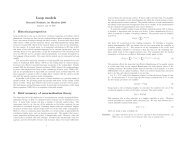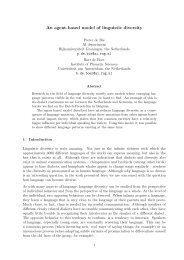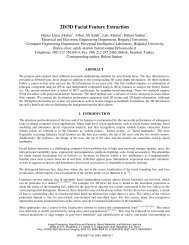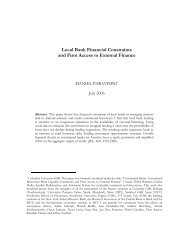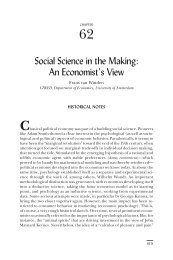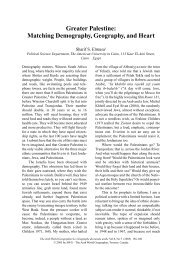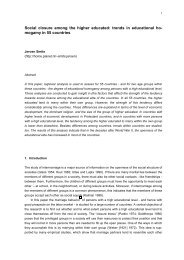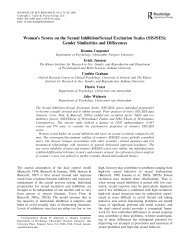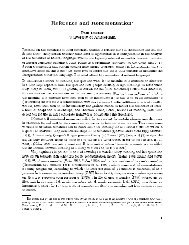44 BLOK ET AL. / EFFECTIVENESS OF EARLY CHILDHOOD EDUCATIONTable 5Parameter estimates for the final <strong>mode</strong>l in two domainsCognitivedomain(n ¼ 71)Socioemotionaldevelopment(n ¼ 14)Parameters Coeff. SE Coeff. SEFixed effectsIntegrated effect sizeIntervention in control group (Var. 3)Dummy centre-based (Var. 12) aDummy combined home-/centre-based (Var. 12) aDummy home-based (Var. 12) aInclusion <strong>of</strong> coaching <strong>of</strong> parenting skills (Var. 17)Effect size at pretest (Var. 18)Time <strong>of</strong> measurement (Var. 21)Type <strong>of</strong> posttest score (Var. 22)R<strong>and</strong>om effectsVariance between experimental comparisonsVariance between times <strong>of</strong> measurement–1.02*0.24*0.48*0.42*—0.69*0.63*–0.03*-0.22*0.220.070.090.08—0.110.190.010.070.08*———–0.05————0.03———0.04————0.010.010.010.010.000.000.000.00Test <strong>of</strong> homogeneity Q ¼ 166.80*, df ¼ 63 Q ¼ 76.64*, df ¼ 12— indicates parameter not specified. See Table 1 for the interpretation <strong>of</strong> the variables.a <strong>The</strong> variable <strong>delivery</strong> <strong>mode</strong> (Var. 12) was replaced by dummy variables.* Effects statistically different from zero (p 5 .05).kindergarten, <strong>and</strong> provision <strong>of</strong> social or economic support toparents—showed no relationship with outcome measures.Further, the longitudinal nature <strong>of</strong> the available outcomemeasures allowed us to estimate the fading <strong>of</strong> outcomes afterending <strong>of</strong> interventions. This effect amounted to 0.03 SD peryear. Finally, effect sizes were also <strong>mode</strong>rated by three studydesign characteristics, namely whether or not the control grouphad followed a st<strong>and</strong>ard <strong>programme</strong>, the difference betweenthe experimental <strong>and</strong> the control group at pretesting, <strong>and</strong> theuse <strong>of</strong> gain scores rather than observed scores.<strong>The</strong> results <strong>of</strong> our meta-analysis confirm quantitatively theconclusions reached in narrative syntheses regarding theconsiderably stronger efficacy <strong>of</strong> centre-based <strong>programme</strong>s orcombined centre- <strong>and</strong> home-based <strong>programme</strong>s in thecognitive domain (Barnett, 1995; Bowerman et al., 2001;Farran, 2000; McGuire & Earls, 1991; Ramey & Ramey,1998). <strong>The</strong> results show that the outcomes <strong>of</strong> these <strong>programme</strong>sare about 0.5 SD larger than those <strong>of</strong> home-based<strong>programme</strong>s. <strong>The</strong> overall effectiveness <strong>of</strong> early intervention<strong>programme</strong>s with an educational orientation appeared to benear zero in the socioemotional domain. <strong>The</strong> results <strong>of</strong> thisstudy do not confirm the particular importance <strong>of</strong> a combinedintervention for obtaining effects in this domain as well(Yoshikawa, 1994).Our analyses revealed no evidence <strong>of</strong> a unique contributionto <strong>programme</strong> outcomes <strong>of</strong> age <strong>of</strong> onset, duration, intensity<strong>and</strong> dose <strong>of</strong> the <strong>programme</strong>, or forms <strong>of</strong> parental <strong>and</strong> familysupport, with the exception <strong>of</strong> the provision <strong>of</strong> parenting skills.This seems to contradict conclusions resulting from previousnarrative syntheses (Barnett, 1995; Bryant & Maxwell, 1997;McGuire & Earls, 1991), <strong>and</strong> those presented in quantitativereviews (Leseman, Otter, Blok, & Deckers, 1998; Royce,Darlington, & Murray, 1983) <strong>and</strong> as theoretical considerations(Rutter, 2000). A possible explanation for this is that in these<strong>other</strong> studies, which focused mostly on bivariate relationships,there may have been confounding between these <strong>programme</strong>characteristics <strong>and</strong> the <strong>delivery</strong> format. Recency <strong>of</strong> the<strong>programme</strong>, onset age, <strong>and</strong> <strong>programme</strong> duration appearednot to be significantly related to the <strong>delivery</strong> <strong>mode</strong>. However,centre-based <strong>and</strong> combined home- <strong>and</strong> centre-based <strong>programme</strong>swere on average much more intensive, <strong>and</strong> thereforeprovided a clearly higher dose <strong>of</strong> intervention than home-based<strong>programme</strong>s did. Correlations <strong>of</strong> a dummy variable denotingcentre-based <strong>and</strong> combined home- <strong>and</strong> centre-based <strong>programme</strong>sversus home-based <strong>programme</strong>s with intensityamounted to .76 (p 5 .001) <strong>and</strong> with dose to .47 (p 5.01). <strong>The</strong>refore, the importance <strong>of</strong> <strong>programme</strong> intensity <strong>and</strong><strong>programme</strong> dose may be masked, at least partly, by <strong>delivery</strong><strong>mode</strong>.No effect <strong>of</strong> the continuation <strong>of</strong> the preschool interventioninto elementary school was found in addition to the effect <strong>of</strong>basic <strong>delivery</strong> strategy, which seems to contradict in particularthe rather robust findings <strong>of</strong> three major studies included in thepresent analysis, namely those concerning the CPC&EP, thepreschool plus K2 version <strong>of</strong> the Abecedarian project, <strong>and</strong> theextensions <strong>of</strong> the SFA <strong>programme</strong> into the lower grades. Froma theoretical perspective, enhancing continuity upon transitionsbetween the most important social contexts <strong>of</strong> the youngchild (i.e., home, preschool, <strong>and</strong> elementary school) seems veryimportant to optimise developmental <strong>and</strong> learning gains(Rimm-Kaufman & Pianta, 2000). Again, confounding with<strong>delivery</strong> strategy may be a possible explanation for the lack <strong>of</strong>such effect in the present meta-analysis. No home-based<strong>programme</strong> in the present selection was continued afterkindergarten or transferred into the first grade <strong>of</strong> elementaryschool. This notwithst<strong>and</strong>ing, however, it seems a distinctpossibility that the previously reported significance <strong>of</strong> continuingpreschool interventions into elementary school holds onlyfor the particular <strong>programme</strong>s for which this effect has beenfound.
INTERNATIONAL JOURNAL OF BEHAVIORAL DEVELOPMENT, 2005, 29 (1), 35–47 45In summary, centre-based <strong>and</strong> combined centre- <strong>and</strong> homebased<strong>programme</strong>s were on average characterised by a higherintensity <strong>and</strong> thus a higher dose <strong>of</strong> the intervention than werehome-based <strong>programme</strong>s, <strong>and</strong> they also appeared to be more<strong>of</strong>ten continued into elementary school. <strong>The</strong>se three featureswere related to <strong>programme</strong> efficacy in previous narrativereviews. As we could estimate <strong>mode</strong>ls in which all predictorswere included, we found <strong>delivery</strong> <strong>mode</strong> to be the betterpredictor, leaving no room for unique contributions from <strong>other</strong><strong>programme</strong> characteristics, except the inclusion <strong>of</strong> parentingcoaching. Particularly important in the present results was theadditional strong effect <strong>of</strong> including the coaching <strong>of</strong> parenting<strong>and</strong> parenting skills, which was found to increase the effect sizein the cognitive domain by 0.7 SD.<strong>The</strong> studies reviewed did not provide detailed informationon how parenting coaching <strong>and</strong> parenting skill training affected<strong>programme</strong> outcomes. <strong>The</strong>refore some possible mechanismswill be briefly discussed here. Several studies have pointed tothe importance <strong>of</strong> an emotionally supportive home environmentfor cognitive gains from education in preschool <strong>and</strong>kindergarten (Pianta, Nimetz, & Bennett, 1997; van IJzendoorn,Sagi & Lambermon, 1992). What seems to be crucial isthe child’s trust in social relationships, which transfers from thehome to the centre or school. Parenting coaching in theincluded <strong>programme</strong>s may have improved emotional supportin the family <strong>and</strong> attachment to <strong>other</strong>s (Van Tuijl & Leseman,2004). A different explanation is that <strong>programme</strong>s withparenting coaching have effectively counteracted the frequentlyreported problems with <strong>programme</strong> implementation in highriskgroups, varying from irregular attendance to the reluctance<strong>of</strong> parents to participate in parental activities or to work withthe child at home (Farran, 2000). This may explain why thecoaching <strong>of</strong> parents to provide the support needed (e.g.,bringing children to the centre on time, well-rested, <strong>and</strong> wellnurtured;attending parent–teacher conferences) is associatedwith positive child outcomes.In contrast to the effect <strong>of</strong> parenting skills training, no sucheffect was found for the inclusion <strong>of</strong> a social, health, oreconomic family support component. Note, however, that thistype <strong>of</strong> parent <strong>and</strong> family support may yield important effectsin <strong>other</strong> outcome measures, such as the long-term prevention<strong>of</strong> child abuse <strong>and</strong> neglect (MacLeod & Nelson, 2000), <strong>and</strong> theprevention <strong>of</strong> health problems, emotional problems, <strong>and</strong>conduct disorders in adolescence (Olds et al., 1998; Olds &Kitzman, 1993). Although these outcomes may not be directlyrelevant to short-term cognitive or socioemotional goals, theymay modulate in particular the preservation <strong>of</strong> early effects upinto adulthood <strong>and</strong> their transformation into life-phaserelevantoutcomes, such as social adjustment, economicindependence, <strong>and</strong> positive health behaviour (Yoshikawa,1994).Programme effects do fade over time. Our results confirmprevious observations <strong>of</strong> this phenomenon <strong>and</strong> have resulted ina robust quantitative estimate. <strong>The</strong> mean linear decrease <strong>of</strong> theeffect size based on the nine studies that reported mediumlong-term <strong>and</strong> long-term follow-up results, covering all types <strong>of</strong><strong>programme</strong>s, was estimated at 0.03 SD per year, which is lessthan previously reported (Blok & Leseman, 1996; McKey etal., 1985). Based on this, it would take 10 years for animmediate <strong>programme</strong> effect <strong>of</strong> d ¼ 0.3 (the average effectfound in this study) to completely disappear. According toMcKey et al., who based their conclusions on Head Startevaluation studies conducted before 1982, this would be about2 years. Our selection included more studies with long-termfollow-up measurements than previous reviews did, even up to15 years after withdrawing the intervention (Olds et al., 1998).An important consideration is that the decrease in effect sizemay be nonlinear, with a stronger decrease in the first few yearsafter the intervention, but a less strong decrease in subsequentyears, as hypothesised by Ramey et al. (2000). Many morelong-term outcomes will be needed to test this hypothesis.Few studies in the present meta-analysis—focusing on<strong>programme</strong>s with an educational orientation—reported outcomesin the socio-emotional domain. This finding, which maybe related with our search <strong>and</strong> selection strategy, seems toreflect the predominant cognitive orientation <strong>of</strong> early childhoodintervention <strong>programme</strong>s, despite the growing recognition<strong>of</strong> the strong interrelatedness <strong>of</strong> motivation, emotionallybased self-regulation, <strong>and</strong> cognitive learning in education<strong>programme</strong>s (Barnett, Young, & Schweinhart, 1998; Boekaerts,1999). <strong>The</strong> selected studies that did include socioemotionaloutcome measures revealed a much smaller overalleffect size than was found for cognitive outcomes. However, nostrong negative effects were reported in the studies weinvestigated, in contradiction to the results <strong>of</strong> Haskins (1985)on early centre-based education <strong>programme</strong>s with a strongcognitive emphasis, <strong>and</strong> to the recent findings <strong>of</strong> the EarlyChildcare Network <strong>of</strong> the National Institute <strong>of</strong> Child Health<strong>and</strong> Human Development (NICHD) regarding intensive,early-onset centre-based care (NICHD, 2002). Nonetheless,the observation that early intervention <strong>programme</strong>s with aneducational orientation do not seem to have an impact on thesocioemotional development is worrying, given the interrelatedness<strong>of</strong> motivational, emotional, <strong>and</strong> cognitive processes inpost-intervention school learning. <strong>The</strong> competition betweensocioemotional <strong>and</strong> cognitive-academic goals is also at theheart <strong>of</strong> the debate on developmentally appropriate versusdidactic practices in early childhood education (Marcon, 1999;Schweinhart & Weikart, 1997; Stipek, Feiler, Daniels, &Milburn, 1995).Our study does not indicate <strong>programme</strong> design characteristicsthat are related to socioemotional outcomes for earlyintervention <strong>programme</strong>s with an educational orientation. Thisleaves us with the question how future <strong>programme</strong>s <strong>of</strong> this typeshould be designed to achieve positive effects in the socioemotionaldomain. An interesting <strong>programme</strong> characteristic inthis respect may be the <strong>programme</strong>s’ pedagogical processes(e.g., child-centred versus teacher-directed, developmentalversus didactic curriculum). As noted earlier, the <strong>programme</strong>design characteristics explored here do not fully explain thevariation in effect sizes. <strong>The</strong> process characteristics alluded tohere are obvious c<strong>and</strong>idates to explain the still unexplainedvariation in outcomes. Unfortunately, few studies providesufficient details about the daily processes <strong>and</strong> teacher–childinteractions to determine the impact <strong>of</strong> different pedagogical<strong>mode</strong>ls on cognitive <strong>and</strong> socioemotional outcomes.Finally, our results have two more or less clear implicationsregarding the format or <strong>delivery</strong> <strong>of</strong> future <strong>programme</strong>s. <strong>The</strong>findings provide a strong argument for the <strong>delivery</strong> <strong>of</strong><strong>programme</strong>s in a centre or a combined centre- <strong>and</strong> homebasedformat. Furthermore, the findings suggest to include aparenting skills component, although this probably will onlyaffect the cognitive development <strong>of</strong> children, but not theirsocioemotional abilities. It is difficult to formulate furtherimplications with regard to <strong>programme</strong> intensity <strong>and</strong> length,continuation after kindergarten, <strong>and</strong> the target age <strong>of</strong> children,



